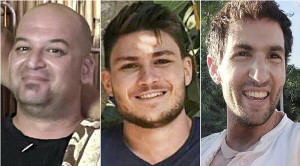Hamas frees 3 hostages, Israel releases hundreds of prisoners as fragile
ceasefire holds
 Send a link to a friend
Send a link to a friend
 [February 15, 2025]
By MOHAMMAD JAHJOUH, MELANIE LIDMAN and JALAL BWAITEL [February 15, 2025]
By MOHAMMAD JAHJOUH, MELANIE LIDMAN and JALAL BWAITEL
KHAN YOUNIS, Gaza Strip (AP) — Hamas-led militants released three male
Israeli hostages Saturday and Israeli forces began releasing hundreds of
prisoners in return, in the latest indication that a fragile ceasefire
that has paused fighting in the Gaza Strip but had teetered in recent
days is holding.
Militants in the southern Gaza Strip paraded the three hostages — Iair
Horn, 46, a dual citizen of Israel and Argentina; American-Israeli Sagui
Dekel Chen, 36; and Russian-Israeli Alexander (Sasha) Troufanov, 29 —
before a crowd before releasing them.
All had been abducted from Kibbutz Nir Oz, a community that was hard-hit
in the Oct. 7, 2023, attack that ignited the war. They appeared pale and
worn, but seemed in better physical condition than the three men
released last Saturday, who had emerged emaciated from 16 months of
captivity.
The truce that began nearly four weeks ago had been jeopardized in
recent days by a tense dispute that threatened to renew the fighting.
U.S. President Donald Trump’s controversial proposal to remove more than
2 million Palestinians from Gaza and settle them elsewhere in the region
has cast even more doubt on the future of the ceasefire.
But Hamas said Thursday it would move ahead with the release of more
hostages after talks with Egyptian and Qatari officials. The group said
the mediators had pledged to “remove all hurdles” to ensure Israel would
allow more tents, medical supplies and other essentials into Gaza.

As with previous exchanges, the hostage release was heavily
choreographed, with the captives made to walk onto a stage and speak
into microphones before the crowd. Dozens of masked, armed Hamas
fighters lined up near the stage festooned with Palestinian flags and
banners of militant factions.
In Tel Aviv’s Hostages Square, a huge cheer went up as the hostages were
transferred to the Red Cross. “Iair, Sagui and Sasha are on their way
home!” an announcer said.
In return for the hostages’ release, Israel began releasing 369
Palestinian prisoners and detainees, including 36 serving life sentences
over deadly attacks. A bus carrying the first released prisoners arrived
in the occupied West Bank town of Beitunia and were greeted by a
cheering crowd of relatives and supporters. Some appeared gaunt, and the
Palestinian Red Crescent emergency service said four were immediately
taken for medical treatment.
It is the sixth swap since the ceasefire took effect on Jan. 19. Before
Saturday, 21 hostages and over 730 Palestinian prisoners were freed
during the first phase of the truce.
Who are the hostages and prisoners being released?
Horn was abducted along with his brother, Eitan Horn, who had been
staying with him at the time. Eitan, 37, remains in captivity and is not
on the list of hostages expected to be released in the ceasefire's first
stage.
"Now, we can breathe a little. Our Iair is home after surviving hell in
Gaza," his family said in a statement. “Now, we need to bring Eitan back
so our family can truly breathe.”
Dekel Chen had been working outside when militants stormed the kibbutz.
His pregnant wife, Avital Dekel Chen, hid in a safe room with their two
daughters. She gave birth to their third daughter two months later.
Speaking to Israeli media Saturday, she said she was overwhelmed with
happiness to see Sagui back in Israel, where he will meet his youngest
daughter, Shachar, for the first time.
Troufanov, whose father was killed during the Oct. 7 attack, was taken
hostage along with his grandmother, mother and girlfriend. The three
women were released during a brief ceasefire in November 2023. Troufanov
was informed of his father's death after his release, shortly before
being reunited with his family, who said they were “overwhelmed with
emotion and gratitude” as he crossed into Israeli territory.
Of the 369 Palestinians who were being released from Israeli prisons, 36
were serving life sentences, according to the Hamas-linked Prisoners’
Information Office.

[to top of second column]
|

This combination of images provided by Hostages Family Forum shows
Iair Horn, Alexander (Sasha) Troufanov and Sagui Dekel Chen, who all
were abducted and brought to Gaza on Oct. 7, 2023. (Hostages Family
Forum via AP)

Among the most prominent is Ahmed Barghouti, 48, a close aide of
militant leader and iconic Palestinian political figure Marwan
Barghouti.
Israel sentenced Ahmed Barghouti to life on charges that he
dispatched suicide bombers during the Second Intifada, or
Palestinian uprising, in the early 2000s to carry out attacks that
killed Israeli civilians. He was arrested alongside Marwan Barghouti
in 2002.
Concerns are high about the remaining hostages’ condition
Of the 251 people abducted during the Oct. 7 attack, 73 remain in
Gaza, around half of whom are believed to be dead. Nearly all the
remaining hostages are men, including Israeli soldiers.
Concern has been growing about their condition, particularly after
the release of three last Saturday, who emerged looking emaciated
and frail.
One of them, 65-year-old Keith Siegel, said Friday in a video
message addressed to Trump that his captors treated him worse as the
15-month war intensified, kicking him, spitting on him and holding
him without water or light.
The truce remains very fragile
The ceasefire appeared dangerously close to collapse in recent days.
Hamas had said it would delay the release of the hostages after
accusing Israel of not adhering to their agreement by not allowing
in enough shelters, medical supplies, fuel and heavy equipment for
clearing rubble. Israel said it would resume fighting Saturday
unless hostages were freed.
While the immediate crisis may have been averted, the truce faces a
much bigger challenge with the deal’s first phase set to conclude in
early March. There have not yet been substantive negotiations over
the second phase, in which Hamas would release all remaining
hostages in return for an end to the war.
At its height, the fighting displaced 90% of Gaza’s population of
2.3 million. Hundreds of thousands have since returned to their
homes as the ceasefire took hold, though many found only rubble,
buried human remains and unexploded ordnance.
The war has killed over 48,000 Palestinians, mostly women and
children, according to Gaza’s health Ministry, which does not say
how many were fighters. Israel says it has killed over 17,000
militants, without providing evidence.
Trump’s plan increases uncertainty
Trump’s proposal to remove some 2 million Palestinians from Gaza and
settle them elsewhere in the region has thrown the truce’s future
into further doubt.

The idea has been welcomed by Israel’s government. But it has been
strongly rejected by Palestinians and Arab countries. Human rights
groups say it could amount to a war crime under international law.
Trump has proposed that once the fighting ends, Israel would
transfer control of Gaza to the United States, which would then
redevelop it as the “Riviera of the Middle East.”
Prime Minister Benjamin Netanyahu’s far-right allies are already
calling for a resumption of the war after the first phase with the
goal of destroying Hamas and implementing Trump’s plan. The militant
group remains in control of the territory after surviving one of the
deadliest and most destructive military campaigns in recent history.
Hamas may be unwilling to release any more hostages if it believes
the war will resume. The captives are among the only bargaining
chips it has left.
___
Bwaitel reported from Beitunia, West Bank, and Lidman reported from
Tel Aviv, Israel. Waafa Shurafa from Deir al-Balah, Gaza Strip, and
Samy Magdy in Cairo contributed.
All contents © copyright 2025 Associated Press. All rights reserved |